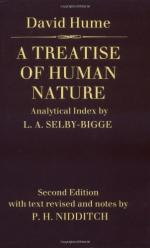We have a distinct idea of an object, that remains invariable and uninterrupted through a supposed variation of time; and this idea we call that of identity or sameness. We have also a distinct idea of several different objects existing in succession, and connected together by a close relation; and this to an accurate view affords as perfect a notion of diversity, as if there was no manner of relation among the objects. But though these two ideas of identity, and a succession of related objects be in themselves perfectly distinct, and even contrary, yet it is certain, that in our common way of thinking they are generally confounded with each other. That action of the imagination, by which we consider the uninterrupted and invariable object, and that by which we reflect on the succession of related objects, are almost the same to the feeling, nor is there much more effort of thought required in the latter case than in the former. The relation facilitates the transition of the mind from one object to another, and renders its passage as smooth as if it contemplated one continued object. This resemblance is the cause of the confusion and mistake, and makes us substitute the notion of identity, instead of that of related objects. However at one instant we may consider the related succession as variable or interrupted, we are sure the next to ascribe to it a perfect identity, and regard it as enviable and uninterrupted. Our propensity to this mistake is so great from the resemblance above-mentioned, that we fall into it before we are aware; and though we incessantly correct ourselves by reflection, and return to a more accurate method of thinking, yet we cannot long sustain our philosophy, or take off this biass from the imagination. Our last resource is to yield to it, and boldly assert that these different related objects are in effect the same, however interrupted and variable. In order to justify to ourselves this absurdity, we often feign some new and unintelligible principle, that connects the objects together, and prevents their interruption or variation. Thus we feign the continued existence of the perceptions of our senses, to remove the interruption: and run into the notion of a soul, and self, and substance, to disguise the variation. But we may farther observe, that where we do not give rise to such a fiction, our propension to confound identity with relation is so great, that we are apt to imagine [Footnote 10] something unknown and mysterious, connecting the parts, beside their relation; and this I take to be the case with regard to the identity we ascribe to plants and vegetables. And even when this does not take place, we still feel a propensity to confound these ideas, though we a-re not able fully to satisfy ourselves in that particular, nor find any thing invariable and uninterrupted to justify our notion of identity.
[Footnote 10 If the reader is desirous to see how a great genius may be influencd by these seemingly trivial principles of the imagination, as well as the mere vulgar, let him read my Lord SHAFTSBURYS reasonings concerning the uniting principle of the universe, and the identity of plants and animals. See his moralists: or, philosophical rhapsody.]




